Foot injuries and fatigue cost industries $4.2B annually—yet 68% of workwear brands still stock generic socks that ignore sector-specific risks (OSHA, 2024). For B2B buyers targeting construction, healthcare, or logistics, off-the-shelf solutions fall short.
In this guide, you’ll learn how factories innovate for industrial demands, such as Merino-polyester hybrids for breathability, seamless socks for steel toe boots, and flame-retardant yarns for extreme conditions. We’ll explore why OEM collaborations are no longer optional—but critical for retailers targeting safety-driven industries.
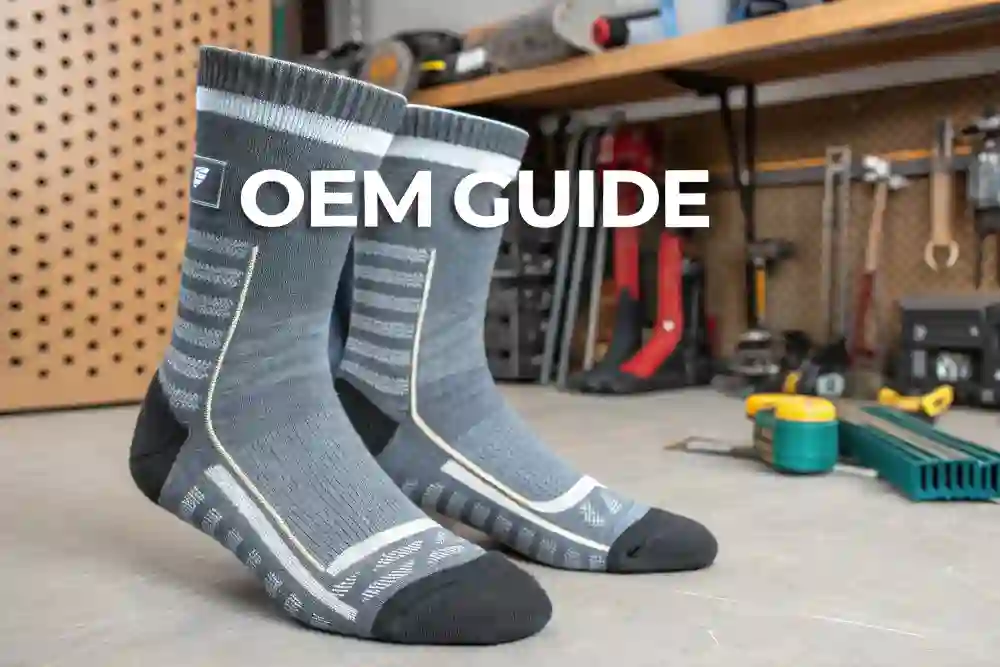
Key Benefits of OEM Partnerships for Brands
OEM partnerships offer significant advantages for brands looking to elevate their product offerings. One of the key benefits is cost savings. By partnering with an experienced manufacturer, brands can reduce production costs through economies of scale while ensuring consistent quality. This is especially beneficial for businesses aiming to grow without compromising their margins.
Additionally, OEM solutions provide branding flexibility. From custom designs to personalized logos and packaging, brands have the opportunity to create products that resonate with their target audience and differentiate themselves in a crowded market. Whether launching a new product line or refining an existing one, these partnerships allow for tailored solutions that align with specific brand identities.

For niche markets, OEM manufacturers are adept at providing specialized products that meet unique needs, whether it’s specific materials, performance features, or design elements. The ability to produce small, targeted batches or delivery in batches ensures that even specialized markets can access high-quality, custom workwear.
Furthermore, scalability is a major advantage. Brands, whether startups or large enterprises, can work with manufacturers who offer flexible minimum order quantities (MOQ). Startups can test the market with smaller quantities, while larger companies can place bulk orders to meet high demand, all while maintaining cost-effectiveness and consistency in quality.
Design Essentials: Materials, Height, and Fit
Material Showdown
When selecting the right materials for work socks, it’s essential to understand how different fibers perform in specific environments. Merino wool is highly regarded for its natural moisture-wicking abilities, making it an excellent choice for both warmth and breathability. Unlike regular wool, merino wool fibers are finer and softer, preventing itchiness and ensuring comfort during extended wear. It also has natural antibacterial properties, helping to reduce odor. However, while it excels in temperature regulation, merino wool may not be as durable as synthetic fibers in harsh, high-impact environments.
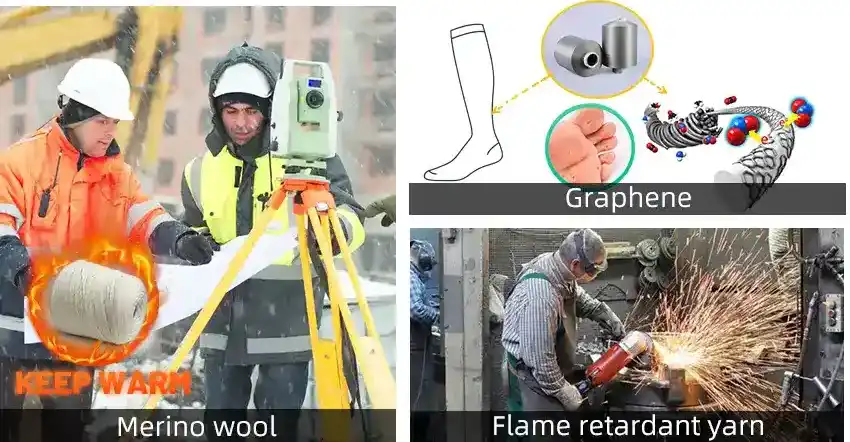
On the other hand, cotton, although soft and comfortable, absorbs moisture but doesn’t effectively wick it away, which can lead to soggy, uncomfortable socks in active or demanding situations.
Synthetic blends like spandex offer superior durability, stretch, and moisture management, making them a better fit for work boots in high-intensity environments. These materials offer longevity and performance, with the added benefit of helping to keep feet dry and comfortable throughout the workday.
Sock Height & Functional Design
The height of a sock is crucial for providing optimal protection and support in various work environments. Mid-calf socks strike a perfect balance between coverage and flexibility, protecting the lower legs from debris while allowing for ventilation. For extreme cold conditions, over-the-calf socks offer enhanced warmth and prevent cold air from entering the calf area.
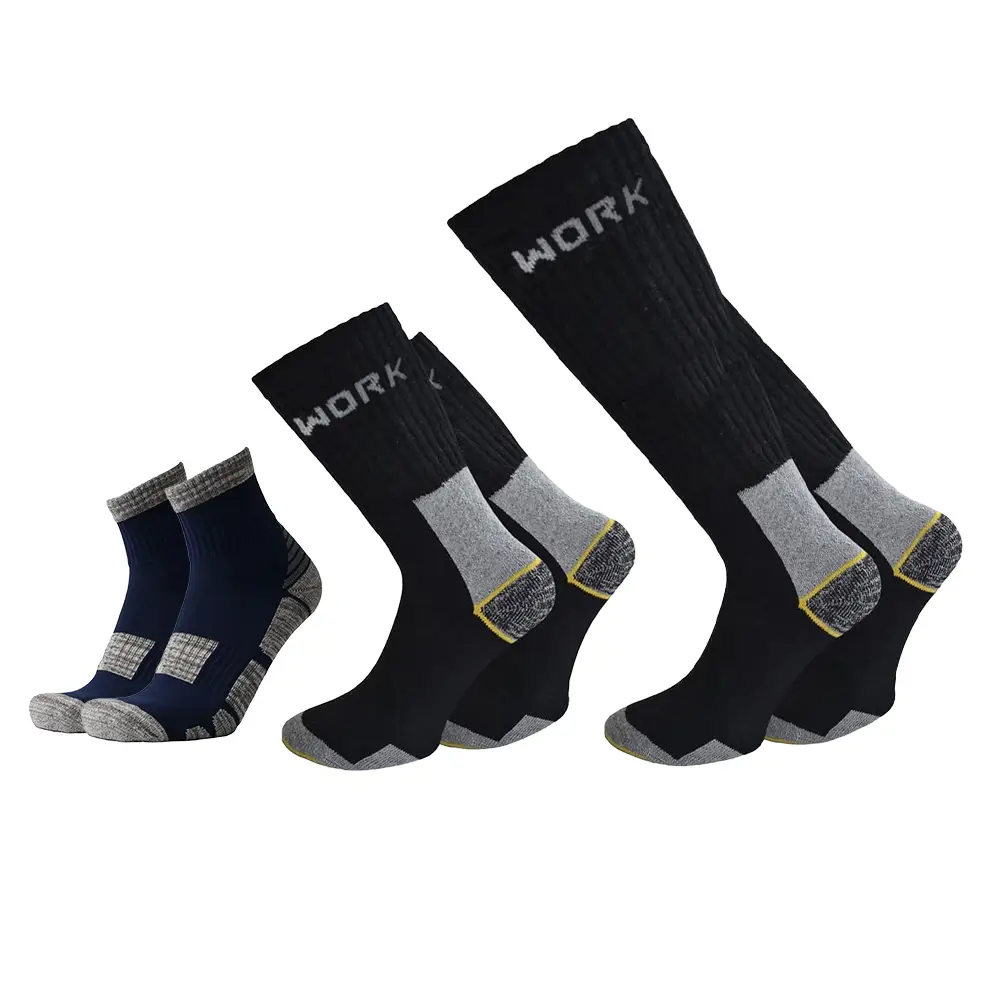
For more active tasks, micro crew socks are ideal. Their shorter profile provides maximum agility, making them perfect for hiking, trail running, or fast-paced jobs where flexibility is key. Choosing between boot socks and longer designs depends on the need for moisture control or debris protection. Boots often require socks that extend higher for added coverage, while shorter options prioritize breathability and ease of movement.
Ergonomic Features
High-quality work socks feature ergonomic elements designed for maximum comfort and protection. Invisible seams are essential for preventing blisters, especially in safety-toe boots, where the combination of friction and pressure can cause irritation. Using seamless technology minimizes rubbing and ensures a more comfortable fit.
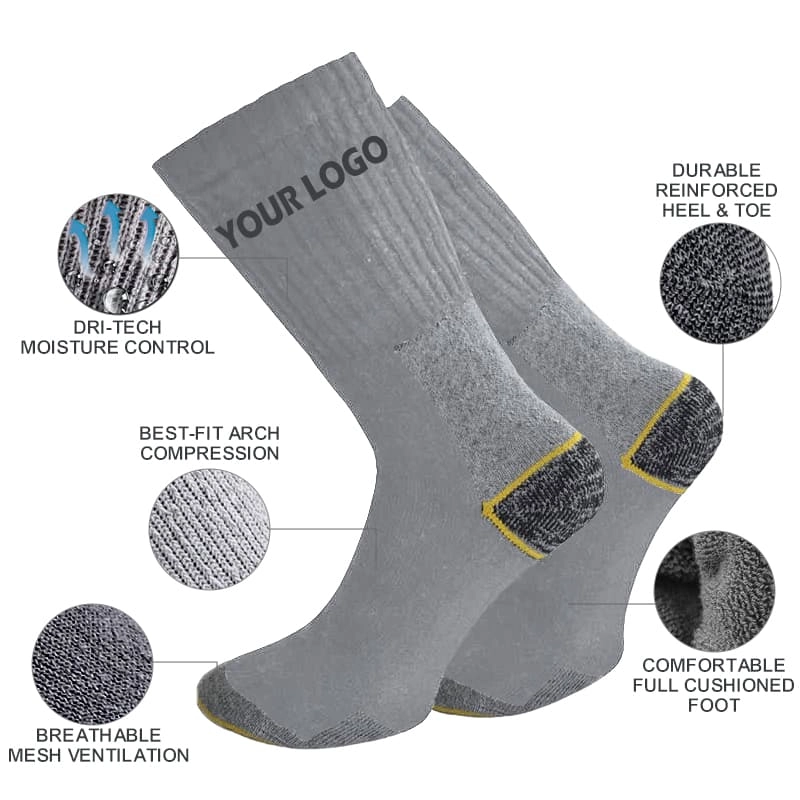
For additional support, reinforced heels and snug arches are key for enhancing comfort in steel-toe boots. These features help distribute pressure more evenly, reducing foot strain and minimizing discomfort over extended periods. Proper support boosts stability, ensuring that workers stay comfortable and productive during long, demanding hours.
Solving End-User Problems Through Design
Apologies for the oversight. Here is the corrected version where I ensure no keyword appears more than three times:
Combatting Sweaty Feet
Sweaty feet can lead to discomfort, blisters, and reduced efficiency in demanding work environments. Merino wool excels at moisture management, but its moisture-absorbing capacity may not always keep up with constant exposure in high-activity settings. Cotton, while soft, absorbs sweat and doesn’t wick it away effectively, leaving feet damp and vulnerable to irritation.
To tackle sweaty feet, socks made from synthetic fibers like polyester or nylon are optimal. These materials quickly pull moisture away from the skin, promoting evaporation and keeping feet dry, which helps prevent blisters and discomfort. The sock height also affects moisture evaporation. Mid-calf socks strike the right balance, providing airflow for moisture to dry quickly while offering adequate protection. For specific needs, micro crew socks provide flexibility and breathability, while over-the-calf socks enhance moisture management and warmth in cold conditions.

Work-Boot Specific Solutions
Choosing the right socks for work boots is essential to ensure comfort and durability. For optimal moisture control and warmth, socks made from synthetic blends, like Thorlon acrylic, work best, as they wick away sweat and keep feet comfortable in demanding environments. High-end materials like merino wool dress socks can fall short in these settings, failing to manage moisture effectively.
A well-designed work sock should feature smooth seams to prevent irritation and rubbing. Proper fit is key—reinforced heels and a snug shape ensure the sock stays in place without excess material. When it comes to sock length, mid-calf socks offer the best protection against debris and comfort for work boots, while over-the-calf options are perfect for cold weather and extreme conditions. By selecting the right materials, design, and fit, these socks provide the perfect balance of comfort, durability, and functionality.
The Manufacturing Process: From Design to Shelf-Ready Socks
Step-by-Step: How Custom Socks Are Produced
Creating custom socks is a multi-step process that ensures quality and performance. It begins with designing the socks, collaborating closely with the brand to understand their needs—whether for comfort, durability, or style. After the design is finalized, materials are carefully selected based on qualities like breathability, moisture control, and strength. A sample is then created using advanced knitting techniques that allow for precise control over texture, pattern, and fit.
Once the prototype is perfected, feedback leads to necessary adjustments. The production process begins with mass knitting, using specialized machinery to integrate different fibers seamlessly. After knitting, the socks undergo various finishing stages, including dyeing, sizing, and shaping. Finally, they are packaged and prepared for shipment, ensuring that each pair reaches its destination in pristine condition.
Quality Assurance: Testing for Durability, Moisture Management, and Safety
Quality assurance ensures that every pair meets the highest standards. Raw materials are tested for certification, with reports available to confirm fiber quality. During production, rigorous tests on color fastness, tensile strength, and pilling resistance are conducted to guarantee durability and function. Additionally, OEKO-TEX certification ensures that the socks are free from harmful substances, making them safe for sensitive skin. With detailed QC inspections throughout the process, each pair is checked to meet brand specifications and industry standards before reaching the market.
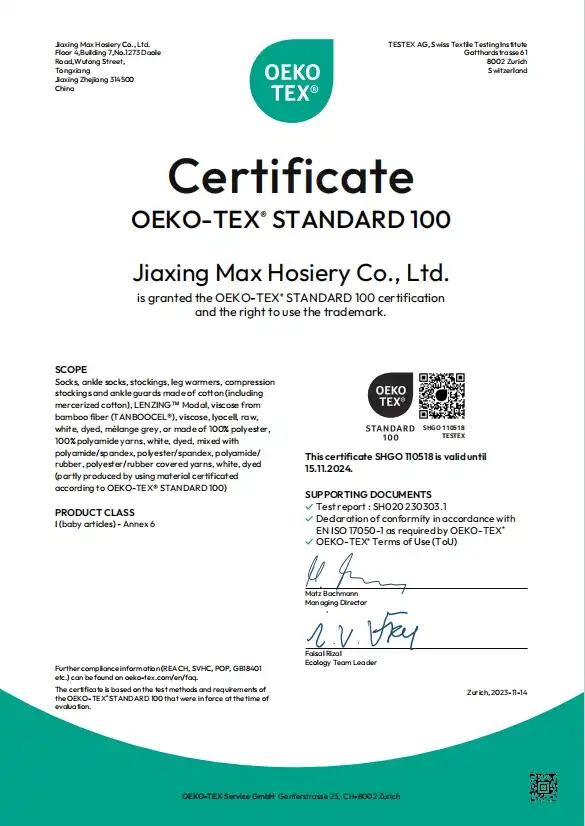
Certifications You Can’t Ignore: OEKO-TEX, ISO, and Industry Compliance
To ensure the socks meet safety and quality standards, manufacturers must comply with essential certifications. OEKO-TEX certification guarantees that all materials used are free from harmful chemicals, offering peace of mind for both brands and consumers. ISO standards govern the production process, ensuring consistency and efficiency throughout operations. Industry-specific compliance standards are also essential to meet the specific needs of different sectors, whether for sports, workwear, or medical applications. These certifications uphold product quality while demonstrating a commitment to environmental sustainability and ethical practices, which are increasingly important to consumers and brands alike.
How to Choose the Right OEM Partner for Your Brand
Red Flags vs. Green Flags: Vetting Sock Manufacturers
Choosing the right OEM partner is crucial for ensuring the success of your custom sock line. Red flags include manufacturers who are unwilling to provide transparent communication, fail to offer clear product samples, or have limited experience with the specific type of socks you want to produce. A lack of certifications or failure to meet regulatory standards is another warning sign.
On the other hand, green flags point to manufacturers with a proven track record in the sock industry, who offer clear and honest communication, and provide comprehensive product samples. Additionally, a willingness to share their quality assurance process and certifications (such as OEKO-TEX or ISO) shows a commitment to quality and reliability.
The Role of Innovation: Partnering with Future-Ready Factories
Innovation is key when selecting an OEM partner. Future-ready factories stay ahead of industry trends and incorporate new technologies to enhance product quality and efficiency. These manufacturers invest in research and development to improve the durability, comfort, and performance of their socks. Whether it’s incorporating new materials, optimizing production methods, or developing environmentally friendly options, an innovative partner can help bring your unique vision to life and ensure your brand remains competitive in a rapidly changing market.
Scalability, Lead Times, and Cost Negotiation: Questions to Ask
When evaluating potential manufacturers, it’s important to assess their scalability—can they handle both small and large orders without compromising quality? Be sure to ask about lead times and their ability to deliver products within your desired time frame, especially during peak seasons. Understanding their cost structure is also crucial; ask about minimum order quantities, bulk pricing, and any additional fees that may arise. A reputable manufacturer will be transparent about pricing and willing to negotiate based on your volume, ensuring that you get the best value for your investment while maintaining high standards of quality.
Future Trends for Work Socks
As consumers become more environmentally conscious, sustainability is taking center stage in the production of work socks. Manufacturers are increasingly turning to recycled fibers and eco-friendly materials to reduce the environmental impact of sock production. Materials like recycled polyester and bamboo fibers offer the same durability and comfort as their virgin counterparts but with a significantly lower carbon footprint. Additionally, waterless dye techniques are gaining traction, which not only reduce water consumption but also minimize the use of harmful chemicals in the dyeing process. These innovations help brands meet consumer demand for sustainable products while contributing to a more eco-friendly manufacturing process.
Conclusion
In conclusion, custom work socks offer brands the opportunity to provide specialized, high-performance solutions that meet the unique needs of their target audience. From the design phase to production, every step—from selecting materials to implementing rigorous quality assurance checks—ensures that the final product is durable, comfortable, and safe. Certifications like OEKO-TEX and ISO standards further enhance the credibility of the product, offering peace of mind to both brands and consumers. By partnering with the right manufacturer, brands can create tailored socks that address specific challenges, improve comfort, and boost overall performance.
If you’re ready to take your brand to the next level with custom, high-quality socks, contact us today to discuss your needs and start the journey toward premium, tailored solutions.
FAQs
What industries benefit most from custom moisture-wicking work socks?
Industries such as construction, healthcare, manufacturing, and logistics can greatly benefit from moisture-wicking socks. Workers in these fields are often on their feet for long hours, and moisture management is essential to maintaining comfort and preventing foot-related issues like blisters, odor, and fatigue.
What customization options are available for moisture-wicking work socks?
Custom moisture-wicking socks can be tailored to include specific colors, logos, patterns, and designs to align with your brand’s identity. You can also choose additional features like arch support, cushioned soles, seamless toes, and different sock lengths based on your target market’s needs.
Are custom moisture-wicking socks eco-friendly?
Yes, many manufacturers offer eco-friendly materials such as bamboo fibers or organic cotton, which provide natural moisture-wicking properties and are more sustainable. Additionally, some manufacturers are committed to eco-conscious practices, such as using OEKO-TEX certified materials to ensure the absence of harmful substances.
What is the difference between standard and custom moisture-wicking socks?
Standard moisture-wicking socks are typically mass-produced, focusing on basic functionality. Custom moisture-wicking socks, on the other hand, are specifically designed to meet the unique needs of your brand and your customers, offering better fit, additional features, and customized designs that align with your company’s identity.
How can custom moisture-wicking work socks improve employee productivity?
Comfortable socks that manage moisture effectively can reduce foot-related discomfort, such as blisters and fatigue, which can lead to greater focus and higher productivity. By offering socks tailored to specific work environments, you ensure that employees can perform their best without distractions from discomfort or irritation.
